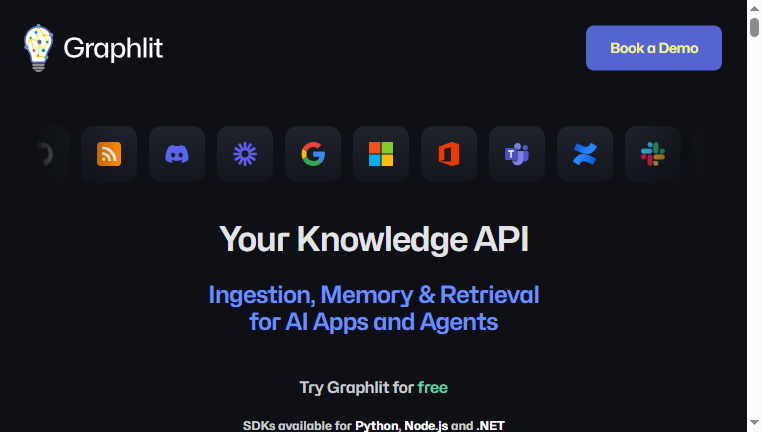Graphlit
Graphlit is a versatile platform for integrating large language models into projects and managing unstructured data. It facilitates the creation of dynamic AI applications by enabling seamless data ingestion from various sources like websites, Slack, and cloud storage. Utilizing SDKs for prominent p... Read More
More Detail
Graphlit is a versatile platform for integrating large language models into projects and managing unstructured data. It facilitates the creation of dynamic AI applications by enabling seamless data ingestion from various sources like websites, Slack, and cloud storage. Utilizing SDKs for prominent programming languages, Graphlit streamlines the process of data transformation and retrieval, enhancing the efficiency of AI-driven applications.
What you can do with Graphlit and why it’s useful
◆Main Functions and Features
・Data Ingestion
Graphlit allows the ingestion of data from multiple sources including web pages, cloud storage, and collaboration tools like Slack. This versatility enables users to harness a wide variety of unstructured data for analysis and processing.
・Integration SDKs
With available SDKs for Python, Node.js, and .NET, developers can quickly integrate Graphlit into their applications. This simplifies the programming process, allowing for quicker deployment of AI solutions.
・Memory and Retrieval
The memory and retrieval framework within Graphlit enhances the app's ability to store and access data efficiently. This feature ensures that previously ingested data can be easily recalled during AI interactions.
・Support for Various Formats
Graphlit supports ingestion of numerous data formats such as documents, HTML, and audio. This flexibility allows developers to work with diverse content types, broadening the potential applications of the tool.
・Real-time Processing
The capability for real-time data processing means that applications can provide instantaneous responses based on the most current data available. This is particularly beneficial for interactive AI experiences.
・Agent Tools Compatibility
Graphlit is compatible with various agent tools like Crew.AI, enabling users to deploy AI agents efficiently. This integration expands the scope of use cases that Graphlit can address.
◆Use Cases and Applications
・Dynamic Application Development
Graphlit can be utilized to build dynamic AI applications that require constant data updates. Its integration capabilities make it suitable for applications in e-commerce and customer support that rely on real-time data.
・Data Analysis in Research
Researchers can use Graphlit to aggregate and analyze data from various sources, significantly reducing the time spent on data collection and processing. This is ideal for academic or market research projects.
・Knowledge Base Creation
Organizations can create centralized knowledge bases by ingesting data from documents and communication platforms. This allows for improved information management across teams, contributing to enhanced productivity.
・Content Generation
Graphlit assists in content generation by extracting data insights from various formats, applying them in dynamic environments such as blogs or social media.
・AI Agent Deployment
Businesses can leverage Graphlit to deploy intelligent agents that respond to customer queries based on the comprehensive datasets ingested. This can improve customer interactions and streamline support processes.
Graphlit :Q&A
Who can use Graphlit?
Geared toward engineers tracking trends, startups, R&D teams, investors, and AI enthusiasts.
What are the main use cases for Graphlit?
Used for testing cutting-edge algorithms, trialing beta tools, evaluating new features, conducting competitive research, and tracking trends.
Is Graphlit free or paid?
Most tools offer free trials, but full versions are typically subscription- or token-based.
Copyright © 2025 AI Ranking. All Right Reserved

